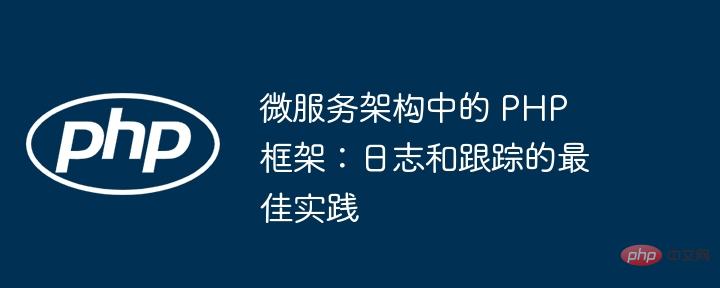Home >Backend Development >PHP Tutorial >PHP Framework in Microservices Architecture: Best Practices for Logging and Tracing
PHP Framework in Microservices Architecture: Best Practices for Logging and Tracing
- WBOYWBOYWBOYWBOYWBOYWBOYWBOYWBOYWBOYWBOYWBOYWBOYWBOriginal
- 2024-06-01 20:55:01677browse
In a microservices architecture, logging and tracing best practices for PHP frameworks include: Logging: Use standardized formats, classify according to severity levels, record contextual information, and choose an appropriate PHP logging library. Tracing: Use distributed tracing solution, pass tracing ID, troubleshoot with tracing data, integrate PHP tracing library.

PHP Framework in Microservice Architecture: Best Practices for Logging and Tracing
In microservice architecture, logging and Tracing is critical for debugging, troubleshooting, and performance optimization. The following is a best practice guide for implementing logging and tracing using PHP frameworks:
Logging
- Use standardized log formats: Use the PSR-3 logging interface or a similar standardized format to ensure logging consistency and portability.
- Classification by severity level: Use log levels (such as information, warning, error) to classify log messages to easily distinguish different types of problems.
- Log contextual information: Include contextual information such as user ID, request ID, or server timestamp to provide additional insights into the environment when an exception or problem occurs.
- Choose logging libraries wisely: PHP provides many logging libraries such as Monolog, Psr\Log, and KiwiLogger. Choose the library that best suits your specific needs.
Code Example:
// 通过 PSR-3 接口记录事件
use Psr\Log\LoggerInterface;
$logger = getLogger();
$logger->info('Successfully processed request');Tracking
- Using a distributed tracing solution :Consider using a distributed tracing solution such as Zipkin, Jaeger, or OpenCensus, which can track requests across services.
- Pass the tracking ID to all services: Pass the tracking ID in the request header or context to maintain the continuity of the tracking context across all service calls.
- Troubleshooting with trace data: Use trace data to visualize and analyze the request flow, identify bottlenecks, and resolve performance issues.
- Integrate PHP tracing libraries: Use PHP tracing libraries such as OpenTracing, Zipkin PHP, and Jaeger PHP to integrate with distributed tracing solutions.
Code example:
// 通过 Zipkin PHP 记录跟踪数据
use Zipkin\TracingFactory;
$factory = TracingFactory::create();
$sampler = new ProbabilityBasedSampler(0.1);
$tracer = $factory->createTracer('Service Name', $sampler);
$tracer->startRootSpan('user_registration');Practical case
Consider a simple e-commerce microservice architecture, which includes The following services:
- User Services: Handles user registration and management.
- Order Service: Handles order creation and processing.
Logging integration:
- Use the PSR-3 logging interface in the user and order services to record user registration and order creation events.
- Categorize log messages based on severity levels to easily differentiate between information, warnings, and errors.
- Log contextual information such as user ID, order ID, etc. to provide additional insights.
Tracking Integration:
- Integrate the Zipkin PHP tracking library into the user and order services.
- Pass the tracking ID to all service calls to maintain tracking context continuity.
- Use Zipkin UI or other tools to analyze trace data to identify performance bottlenecks and resolve issues.
The above is the detailed content of PHP Framework in Microservices Architecture: Best Practices for Logging and Tracing. For more information, please follow other related articles on the PHP Chinese website!

